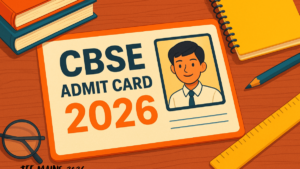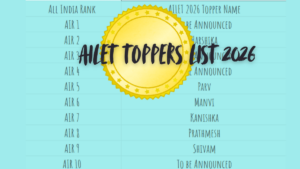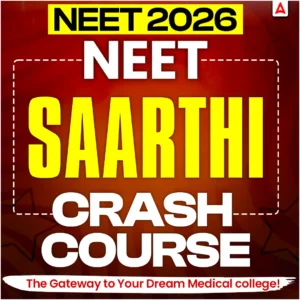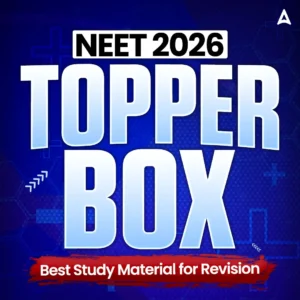Candidates who are preparing for the Joint Entrance Examination Main in 2026 can look at the JEE Main Physics syllabus of 2025. It will take some time because the National Testing Agency (NTA) has not yet officially declared the JEE Main Physics Syllabus 2026; however, the JEE Main 2025 syllabus has been declared as a PDF. Candidates could have a look at preparing for the exam. The syllabus of JEE Main is the same as the syllabus of last year.
JEE Main Physics Syllabus 2026
The JEE Main 2026 Physics syllabus is not available yet. But the syllabus will be based on the NCERT syllabus of Classes 11 and 12. The JEE Main has two sections during the examination. The first section is Part A (theory), which will be for about 80% of the paper, and Part B (practical and experimental sledges) for the other 20%. Candidates should follow the JEE Main 2025 physics syllabus until NTA releases and confirms the official syllabus.
In general terms, for Physics 50–55% of questions come from Class 11 material, predominantly Mechanics and Waves, while the remaining Constant (i.e., 45–50%) comes from Class 12 material, i.e., Electrodynamics and Modern Physics is the most relevant.
JEE Main Physics Syllabus: Section A
The JEE Main Physics Syllabus for Section A includes the very basics of Physics, Mechanics, Rotations, Work and Energy, Laws of Motion, Gravitation, and Thermodynamics. The candidate has to cover all these topics to score well in the exam.
|
Units |
Topics |
|
Units and Measurements |
Units of measurements, System of units, SI Units, fundamental and derived units, least count, significant figures, Errors in measurements. Dimensions of Physics quantities, dimensional analysis and its applications. |
|
Kinematics |
The frame of reference, motion in a straight line, speed and velocity, uniformand non-uniform motion, average speed and instantaneous velocity, uniformly accelerated motion, velocity-time, position-time graph, relations for uniformly accelerated motion, relative velocity. Motion in a plane, projectile motion, uniform circular motion |
|
Laws of Motion |
Force and inertia, Newton’s first law of motion, momentum, Newton’s secondLaw of motion, impulse, Newton’s third Law of motion. Law of conservation of linear momentum and its applications, equilibrium of concurrent forces. Static and Kinetic friction, laws of friction, rolling friction. Dynamics of uniform circular motion, centripetal force and its applications: vehicle on a level circular road, vehicle on a banked road. |
|
Work, Energy and Power |
Work done by a constant force and a variable force, kinetic and potential energies, work-energy theorem, power. The potential energy of a spring, conservation of mechanical energy, conservative and non- conservative forces, motion in a vertical circle. Elastic and inelastic collisions in one and two dimensions. |
|
Rotational Motion |
Centre of mass of a two-particle system, centre of mass of a rigid body. Basic concepts of rotational motion, moment of a force, torque, angular momentum, conservation of angular momentum and its applications. The moment of inertia, the radius of gyration, values of moments of inertia for simple geometrical objects, parallel and perpendicular axes theorems and their applications. Equilibrium of rigid bodies, rigid body rotation and equations of rotational motion, comparison of linear and rotational motions. |
|
Gravitation |
The universal law of gravitation. Acceleration due to gravity and its variationwith altitude and depth. Kepler’slaw of planetary motion. Gravitational potential energy, gravitational potential. Escape velocity, motion of a satellite, orbital velocity, time period and energy of satellite |
|
Properties of Solids and Liquids |
Elastic behaviour, stress-strain relationship, Hooke’s Law, Young’s modulus, bulk modulus and modulus of rigidity. Pressure due to a fluid column, Pascal’s law and its applications, effect of gravity on fluid pressure, viscosity, Stoke’s law, terminal velocity, streamline and turbulent flow, critical velocity, Bernoulli’s principle and its applications. Surface energy and surface tension, angle of contact, excess of pressure across a curved surface, application of surface tension: drops, bubbles and capillary rise. Heat, temperature, thermal expansion, specific heat capacity, calorimetry, change of state, latent heat. Heat transfer: conduction, convection and radiation. |
|
Thermodynamics |
Thermal equilibrium and the concept of temperature, zeroth law of thermodynamics, heat, work and internal energy. The first law of thermodynamics, isothermal and adiabatic processes. The second law of thermodynamics: reversible and irreversible processes. |
|
Kinetic Theory of Gases |
Equation of state of a perfect gas, work done on compressing a gas, kinetic theory of gases: assumptions, the concept of pressure, kinetic interpretation of temperature, RMS speed of gas molecules, degrees of freedom, law of equipartition of energy and applications to specific heat capacities of gases, mean free path, Avogadro’s number. |
|
Oscillations and Waves |
Oscillations and periodic motion: time period, frequency, displacement as a function of time, periodic functions. Simple harmonic motion (S.H.M.) and its equation, phase, oscillations of a spring: restoring force and force constant, energy in S.H.M.: kinetic and potential energies, simple pendulum: derivation of expression for its time period. Wave motion, longitudinal and transverse waves, speed of the travelling wave, displacement relation for a progressive wave, principle of superposition of waves, reflection of waves, standing waves in strings and organ pipes, fundamental mode and harmonics, beats |
|
Electrostatics |
Electric charges: conservation of charge, Coulomb’s law forces between two point charges, forces between multiple charges, superposition principle and continuous charge distribution. Electric field: electric field due to a point charge, electric field lines, electric dipole, electric field due to a dipole, torque on a dipole in a uniformelectric field. Electric flux, Gauss’s law and its applications to find fields due to infinitely long uniformly charged straight wire, uniformly charged infinite plane sheet and uniformly charged thin spherical shell. Electric potential and its calculation for a point charge, electric dipole and system of charges, potential difference, equipotential surfaces, electrical potential energy of a system of two point charges and of electric dipole in an electrostatic field. Conductors and insulators, dielectrics and electric polarization, capacitors and capacitance, the combination of capacitors in series and parallel and capacitance of a parallel plate capacitor with and without dielectric medium between the plates, energy stored in a capacitor. |
|
Current Electricity |
Electric current: drift velocity, mobility and their relation with electric current, Ohm’s law, electrical resistance, I-V characteristics of Ohmic and non-ohmic conductors, electrical energy and power, electrical resistivity and conductivity, series and parallel combinations of resistors, temperature dependence of resistance. Internal resistance, potential difference and emf of a cell, a combination of cells in series and parallel. Kirchhoff’s laws and their applications, Wheatstone bridge, Metre Bridge |
|
Magnetic Effects of Current and Magnetism |
Biot – Savart law and its application to the current carrying circular loop, Ampere’s law and its applications to infinitely long current carrying straight wire and solenoid. Force on a moving charge in uniform magnetic and electric fields, force on a current-carrying conductor in a uniform magnetic field, the force between two parallel currents carrying conductors-definition of ampere, torque experienced by a current loop in a uniform magnetic field: Moving coil galvanometer, its sensitivity and conversion to ammeter and voltmeter. Current loop as a magnetic dipole and its magnetic dipole moment, bar magnet as an equivalent solenoid, magnetic field lines, magnetic field due to a magnetic dipole (bar magnet) along its axis and perpendicular to its axis, torque on a magnetic dipole in a uniform magnetic field, para-, dia- and ferromagnetic substances with examples, the effect of temperature on magnetic properties |
|
Electromagnetic Induction and Alternating Currents |
Electromagnetic induction: Faraday’s law, induced emf and current, Lenz’s law, eddy currents, self and mutual inductance. Alternating currents, peak and RMS value of alternating current/voltage, reactance and impedance, LCR series circuit, resonance, power in AC circuits, wattless current, AC generator and transformer. |
|
Electromagnetic Waves |
Displacement current, electromagnetic waves and their characteristics, transverse nature of electromagnetic waves, electromagnetic spectrum(radiowaves, microwaves, infrared, visible, ultraviolet, X-rays, Gamma rays), applications of electromagnetic waves. |
|
Optics |
Reflection of light, spherical mirrors, mirror formula. Refraction of light at plane and spherical surfaces, thin lens formula and lens maker formula, total internal reflection and its applications, magnification, power of a lens, combination of thin lenses in contact, refraction of light through a prism, microscope and astronomical telescope (reflecting and refracting ) and their magnifying powers. Wave optics: wavefront and Huygens ‘Principle, laws of reflection and refraction using Huygens principle. Interference: Young’s double-slit experiment and expression for fringe width, coherent sources and sustained interference of light. Diffraction due to a single slit, width of central maximum. Polarization: plane-polarized light, Brewster’s law, uses of plane- polarized light and Polaroid. |
|
Dual Nature of Matter and Radiation |
Dual nature of radiation, Photoelectric effect, Hertz and Lenard’s observations, Einstein’s photoelectric equation, particle nature of light. Matter waves: wave nature of particle, de- Broglie relation. |
|
Atoms and Nuclei |
Alpha-particle scattering experiment, Rutherford’s model of atom, Bohr model, energy levels, hydrogen spectrum. Composition and size of nucleus, atomic masses, mass-energy relation, mass defect, binding energy per nucleon and its variation with mass number, nuclear fission and fusion. |
|
Electronic Devices |
Semiconductors, semiconductor diode: I-V characteristics in forward and reverse bias, diode as a rectifier; I-V characteristics of LED, the photodiode, solar cell, Zener diode, Zener diode as a voltage regulator. Logic gates (OR. AND. NOT. NAND and NOR). |
JEE Main Physics Syllabus 2026: Section B
It includes practical-based subjects like Vernier Callipers, Screw Gauge, Metre Scale, Characteristic Curves, and Measurement of Resistance. And this section consists totally of Physics Lab Experiments-based questions. The table given below will guide you:
|
S.No. |
Topics |
|
1 |
Vernier callipers-its used to measure the internal and external diameter and depth of a vessel. |
|
2 |
Screw gauge-its use is to determine the thickness/ diameter of a thin sheet/wire |
|
3 |
Simple Pendulum- dissipation of energy by plotting a graph between the square of amplitude and time. |
|
4 |
Metre Scale – the mass of a given object is determined by the principle of moments. |
|
5 |
Young’s modulus of elasticity of the material of a metallic wire. |
|
6 |
Surface tension of water by capillary rise and the effect of detergents, |
|
7 |
Coefficient of Viscosity of a given viscous liquid by measuring the terminal velocity of a given spherical body, |
|
9 |
Speed of sound in air at room temperature using a resonance tube |
|
10 |
Specific heat capacity of a given |
|
11 |
The resistivity of the material of a given wire using a metre bridge. |
|
12 |
The resistance of a given wire is calculated using Ohm’s law. |
|
14 |
Resistance and figure of merit of a galvanometer by half half-deflection method. |
|
15 |
The focal length of |
|
16 |
The plot of the angle of deviation vs the angle of incidence for a triangular prism |
|
17 |
The Refractive index of a glass slab using a travelling microscope. |
|
18 |
Characteristic curves of a p-n junction diode in forward and reverse bias. |
|
19 |
Characteristic curves of a Zener diode and finding the reverse breakdown voltage. |
|
20 |
Identification of Diode. LED, Transistor. IC. Resistor. A capacitor from a mixed collection of such items. |
Chapter-wise JEE Main Physics Syllabus Weightage
JEE Main 2026 Weightage for the Physics chapter relies on question papers of previous years. Notice that the first 9 chapters alone contain (50% marking). The weightage list (questions referenced & weightage) is mentioned below, which you can use to identify the important topics and chapters which were frequently asked during JEE Main.
|
Chapters |
Total Questions |
Weightage |
|---|---|---|
|
Electrostatics |
1 |
3.3% |
|
Capacitors |
1 |
3.3% |
|
Simple Harmonic Motion |
1 |
3.3% |
|
Sound Waves |
1 |
3.3% |
|
Elasticity |
1 |
3.3% |
|
Error in Measurement |
1 |
3.3% |
|
Circular Motion |
1 |
3.3% |
|
Electromagnetic Waves |
1 |
3.3% |
|
Semiconductors |
1 |
3.3% |
|
Communication Systems |
1 |
3.3% |
|
Magnetic Effect of Current and Magnetism |
2 |
6.6% |
|
Alternating Current |
2 |
6.6% |
|
Kinetic Theory of Gases & Thermodynamics |
2 |
6.6% |
|
Kinematics |
2 |
6.6% |
|
Work, Energy, and Power |
2 |
6.6% |
|
Laws of Motion |
2 |
6.6% |
|
Centre Of Mass |
2 |
6.6% |
|
Rotational Dynamics |
2 |
6.6% |
|
Modern Physics |
2 |
6.6% |
|
Wave Optics |
2 |
6.6% |
|
Current Electricity |
3 |
9.9% |
Books For JEE Main Physics
Students should choose the correct book for their JEE Main preparation. Which books you choose will play a bigger part in how much the student will score at the end in the exam. Candidates are provided here some of the best books for JEE Main Physics preparation mentioned below:
| Name of Book | Author/Publisher |
|---|---|
| Fundamentals of Physics | Halliday, Resnick and Walker |
| Problems and Solutions of Physics | Sashi Bhusan Tiwari |
| Concepts of Physics, Volume 1 and 2 | H.C. Verma |
| NCERT Textbooks for Class 11 and 12 | NCERT |
| Understanding Physics for JEE Main & Advanced | D.C. Pandey, Arihant Publications |










 CBSE Admit Card 2026 for Private & R...
CBSE Admit Card 2026 for Private & R...
 AILET 2026 AIR 1: Check Full Toppers Lis...
AILET 2026 AIR 1: Check Full Toppers Lis...
 AILET Result 2026 OUT, How to Download S...
AILET Result 2026 OUT, How to Download S...














